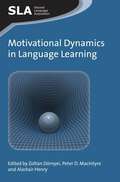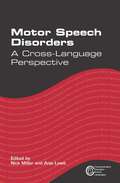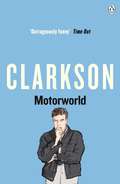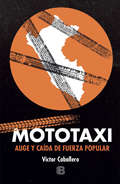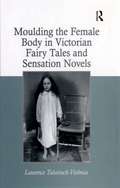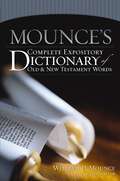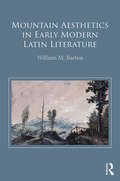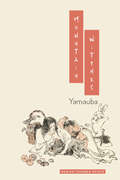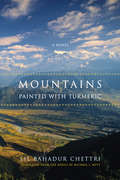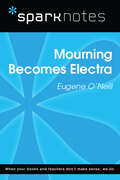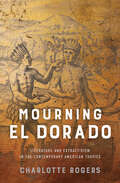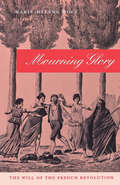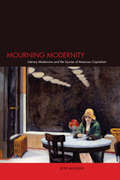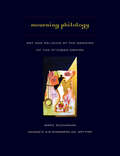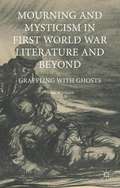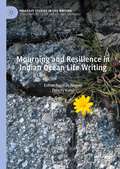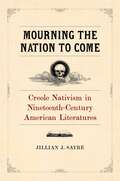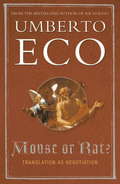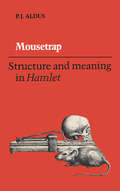- Table View
- List View
Motivational Dynamics in Language Learning
by Zoltán Dörnyei Peter D. MacintyreThis landmark volume offers a collection of conceptual papers and empirical research studies that investigate the dynamics of language learning motivation from a complex dynamic systems perspective. The contributors include some of the most well-established scholars from three continents, all addressing the question of how we can understand motivation if we perceive it as continuously changing and evolving rather than as a fixed learner trait. The data-based studies also provide useful research models and templates for graduate students and scholars in the fields of applied linguistics and SLA who are interested in engaging with the intriguing area of examining language learning in a dynamic vein.
Motor Speech Disorders
by Anja Lowit Nick MillerMotor speech disorders are a common accompaniment of a whole range of neurological conditions, from stroke, brain injury and Parkinson's disease through to many rarer conditions. This book aims to aid understanding of the nature of motor speech disorders from a cross-language perspective, in contrast to the largely English-centric nature of research and practice recommendations to date. The book looks not just at how these motor speech disorders are assessed and treated in other countries, but also examines how underlying speech impairments differ according to the language someone speaks. The book studies the underlying neurological, neurophysiological and neurophonetic characteristics of motor speech disorders in different language contexts, and discusses the implications these have for clinical rehabilitation. This significantly adds to debates around the theoretical understanding and clinical management of motor speech disorders.
Motor and Sensory Processes of Language (Neuropsychology and Neurolinguistics Series)
by Eric Keller Myrna GopnikPublished in 1987, Motor and Sensory Processes of Language is a valuable contribution to the field of Cognitive Psychology.
Motorworld
by Jeremy ClarksonJeremy Clarkson invites us to Motorworld, his take on different cultures and the cars that they drive.There are ways and means of getting about that don't involve four wheels, but in this slice of vintage Clarkson, Jeremy isn't much interested in them.Back in 1996, he took himself off to twelve countries (okay, eleven - he goes to America twice) in search of the hows, whys and wherefores of different nationalities and their relationships with cars. There were a few questions he needed answers to:* Why, for instance, is it that Italians are more interested in looking good than looking where they are going?* Why do Indians crash a lot?* How can an Arab describe himself as 'not a rich man' with four of the world's most expensive cars in his drive? * And why have the otherwise neutral Swiss declared war on the car?From Cuba to Iceland, Australia to Vietnam, Japan to Texas, Jeremy Clarkson tells us of his adventures on and off four wheels as he seeks to discover just what it is that makes our motorworld tick over. _____________Praise for Jeremy Clarkson:'Brilliant . . . laugh-out-loud' Daily Telegraph'Outrageously funny . . . will have you in stitches' Time Out'Very funny . . . I cracked up laughing on the tube' Evening Standard
Mototaxi
by Víctor Caballero"Mototaxi no busca favorecer o perjudicar a nadie. La historia se encargará de eso". Sumergirse detrás de cámaras es lo opuesto al oficio del youtuber. Ponerse delante de un lente en la comodidad de tu habitación es totalmente lo contrario a salir a la calle a buscar la historia que nadie registró en video. Con Mototaxi, Víctor Caballero ha logrado transitar airoso ese camino. Conocido por El diario de Curwen, el canal de Youtube que se convirtió en una referencia ineludible para toda una generación, en este libro Caballero demuestra que su esencia es el periodismo, sin importar su envase. Una narración apasionada y detallista del período más turbulento de la democracia peruana del siglo XXI, contada desde la perspectiva de "los malos" de la historia: Keiko Fujimori y su corte. Como en sus exitosos videos, aquí lo más importante son los datos, los hechos, la veracidad. Esa siempre fue la esencia de Caballero y ese es el tronco principal de este minucioso recuento de todos los atropellos de la mototaxi que, ahora lo sabemos, condujo nuestros destinos.
Moulding the Female Body in Victorian Fairy Tales and Sensation Novels
by Laurence Talairach-VielmasLaurence Talairach-Vielmas explores Victorian representations of femininity in narratives that depart from mainstream realism, from fairy tales by George MacDonald, Lewis Carroll, Christina Rossetti, Juliana Horatia Ewing, and Jean Ingelow, to sensation novels by Wilkie Collins, Mary Elizabeth Braddon, Rhoda Broughton, and Charles Dickens. Feminine representation, Talairach-Vielmas argues, is actually presented in a hyper-realistic way in such anti-realistic genres as children's literature and sensation fiction. In fact, it is precisely the clash between fantasy and reality that enables the narratives to interrogate the real and re-create a new type of realism that exposes the normative constraints imposed to contain the female body. In her exploration of the female body and its representations, Talairach-Vielmas examines how Victorian fantasies and sensation novels deconstruct and reconstruct femininity; she focuses in particular on the links between the female characters and consumerism, and shows how these serve to illuminate the tensions underlying the representation of the Victorian ideal.
Mounce's Complete Expository Dictionary of Old and New Testament Words
by William D. MounceFor years, Vine’s Expository Dictionary has been the standard word study tool for pastors and laypeople, selling millions of copies. But sixty-plus years of scholarship have shed extensive new light on the use of biblical Greek and Hebrew, creating the need for a new, more accurate, more thorough dictionary of Bible words. William Mounce, whose Greek grammar has been used by more than 100,000 college and seminary students, is the editor of this new dictionary, which will become the layperson’s gold standard for biblical word studies. Mounce’s is ideal for the reader with limited or no knowledge of Greek or Hebrew who wants greater insight into the meanings of biblical words to enhance Bible study. It is also the perfect reference for busy pastors needing to quickly get at the heart of a word’s meaning without wading through more technical studies. What makes Mounce’s superior to Vine’s? · The most accurate, in-depth definitions based on the best of modern evangelical scholarship · Both Greek and Hebrew words are found under each English entry (Vine’s separates them) · Employs both Strong’s and G/K numbering systems (Vine’s only uses Strong’s) · Mounce’s accuracy is endorsed by leading scholars
Mountain Aesthetics in Early Modern Latin Literature
by William M. BartonIn the late Renaissance and Early Modern period, man’s relationship to nature changed dramatically. An important part of this change occurred in the way that beauty was perceived in the natural world and in the particular features which became privileged objects of aesthetic gratification. This study explores the shift in aesthetic attitude towards the mountain that took place between 1450 and 1750. Over the course of these 300 years the mountain transformed from a fearful and ugly place to one of beauty and splendor. Accepted scholarly opinion claims that this change took place in the vernacular literature of the early and mid-18th century. Based on previously unknown and unstudied material, this volume now contends that it took place earlier in the Latin literature of the late Renaissance and Early Modern period. The aesthetic attitude shift towards the mountain had its catalysts in two broad spheres: the development of an idea of ‘landscape’ in the geographical and artistic traditions of the 16th century on the one hand, and the increasing amount of scientific and theological investigation dedicated to the mountain on the other, reaching a pinnacle in the late 17th and early 18th centuries. The new Latin evidence for the change in aesthetic attitude towards the mountain unearthed in the course of this study brings material to light which is relevant for the current philosophical debate in environmental aesthetics. The book’s concluding chapter shows how understanding the processes that produced the late Renaissance and Early Modern shift in aesthetic attitude towards the mountain can reveal important information about the modern aesthetic appreciation of nature. Alongside a standard bibliography of primary literature, this volume also offers an extended annotated bibliography of further Latin texts on the mountains from the Renaissance and Early Modern period. This critical bibliography is the first of its kind and constitutes an essential tool for further study in the field.
Mountain Witches: Yamauba
by Noriko T. ReiderMountain Witches is a comprehensive guide to the complex figure of yamauba—female yōkai often translated as mountain witches, who are commonly described as tall, enigmatic women with long hair, piercing eyes, and large mouths that open from ear to ear and who live in the mountains—and the evolution of their roles and significance in Japanese culture and society from the premodern era to the present. In recent years yamauba have attracted much attention among scholars of women’s literature as women unconstrained by conformative norms or social expectations, but this is the first book to demonstrate how these figures contribute to folklore, Japanese studies, cultural studies, and gender studies. Situating the yamauba within the construct of yōkai and archetypes, Noriko T. Reider investigates the yamauba attributes through the examination of narratives including folktales, literary works, legends, modern fiction, manga, and anime. She traces the lineage of a yamauba image from the seventh-century text Kojiki to the streets of Shibuya, Tokyo, and explores its emergence as well as its various, often conflicting, characteristics. Reider also examines the adaptation and re-creation of the prototype in diverse media such as modern fiction, film, manga, anime, and fashion in relation to the changing status of women in Japanese society. Offering a comprehensive overview of the development of the yamauba as a literary and mythic trope, Mountain Witches is a study of an archetype that endures in Japanese media and folklore. It will be valuable to students, scholars, and the general reader interested in folklore, Japanese literature, demonology, history, anthropology, cultural studies, gender studies, and the visual and performing arts.
Mountains Painted with Turmeric
by Lil Bahadur ChettriSince its publication in the late 1950s, Mountains Painted with Turmeric has struck a chord in the hearts of hundreds of thousands of Nepali readers. Set in the hills of far eastern Nepal, the novel offers readers a window into the lives of the people by depicting in subtle detail the stark realities of village life.Carefully translated from the original text, Mountains Painted with Turmeric tells the story of a peasant farmer named Dhané (which means, ironically, "wealthy one") who is struggling to provide for his wife and son and arrange the marriage of his beautiful younger sister. Unable to keep up with the financial demands of the "big men" who control his village, Dhané and his family suffer one calamity after another, and a series of quarrels with fellow villagers forces them into exile. In haunting prose, Lil Bahadur Chettri portrays the dukha, or suffering and sorrow, endured by ordinary peasants; the exploitation of the poor by the rich and powerful; and the social conservatism that twists a community into punishing a woman for being the victim of a crime. Chettri describes the impoverishment, dispossession, and banishment of Dhané's family to expose profound divisions between those who prosper and those who are slowly stripped of their meager possessions. Yet he also conveys the warmth and intimacy of village society, from which Dhané and his family are ultimately excluded.
Mourning Becomes Electra (SparkNotes Literature Guide Series)
by SparkNotesMourning Becomes Electra (SparkNotes Literature Guide) by Eugene O'Neill Making the reading experience fun! Created by Harvard students for students everywhere, SparkNotes is a new breed of study guide: smarter, better, faster. Geared to what today's students need to know, SparkNotes provides: *Chapter-by-chapter analysis *Explanations of key themes, motifs, and symbols *A review quiz and essay topicsLively and accessible, these guides are perfect for late-night studying and writing papers
Mourning El Dorado: Literature and Extractivism in the Contemporary American Tropics (New World Studies)
by Charlotte RogersWhat ever happened to the legend of El Dorado, the tale of the mythical city of gold lost in the Amazon jungle? Charlotte Rogers argues that El Dorado has not been forgotten and still inspires the reckless pursuit of illusory wealth. The search for gold in South America during the colonial period inaugurated the "promise of El Dorado"—the belief that wealth and happiness can be found in the tropical forests of the Americas. That assumption has endured over the course of centuries, still evident in the various modes of natural resource extraction, such as oil drilling and mining, that characterize the region today.Mourning El Dorado looks at how fiction from the American tropics written since 1950 engages with the promise of El Dorado in the age of the Anthropocene. Just as the golden kingdom was never found, natural resource extraction has not produced wealth and happiness for the peoples of the tropics. While extractivism enriches a few outsiders, it results in environmental degradation and the subjugation, displacement, and forced assimilation of native peoples. This book considers how the fiction of five writers—Alejo Carpentier, Wilson Harris, Mario Vargas Llosa, Álvaro Mutis, and Milton Hatoum—criticizes extractive practices and mourns the lost illusion of the forest as a place of wealth and happiness.
Mourning Glory
by Marie-Hélène HuetMourning Glory sheds light on troubled times as it shows how passion and prejudice, grief and denial all contributed to the continuing creation of a revolutionary legacy that still affects our understanding of the nature of language and history.
Mourning Modernity: Literary Modernism and the Injuries of American Capitalism
by Seth MoglenIn Mourning Modernity, Seth Moglen argues that American literary modernism is, at its heart, an effort to mourn for the injuries inflicted by modern capitalism. He demonstrates that the most celebrated literary movement of the 20th century is structured by a deep conflict between political hope and despair—between the fear that alienation and exploitation were irresistible facts of life and the yearning for a more just and liberated society. He traces this conflict in the works of a dozen novelists and poets – ranging from Eliot, Hemingway, and Faulkner to Hurston, Hughes, and Tillie Olsen. Taking John Dos Passos' neglected U.S.A. trilogy as a central case study, he demonstrates how the struggle between reparative social mourning and melancholic despair shaped the literary strategies of a major modernist writer and the political fate of the American Left. Mourning Modernity offers a bold new map of the modernist tradition, as well as an important contribution to the cultural history of American radicalism and to contemporary theoretical debates about mourning and trauma.
Mourning Philology: Art and Religion at the Margins of the Ottoman Empire
by Marc Nichanian“Pagan life seduces me a little more with each passing day. If it were possible today, I would change my religion and would joyfully embrace poetic paganism,” wrote the Armenian poet Daniel Varuzhan in 1908. During the seven years that remained in his life, he wrote largely in this “pagan” vein. If it was an artistic endeavour, why then should art be defined in reference to religion? And which religion precisely? Was Varuzhan echoing Schelling’s Philosophy of Art?Mourning Philology draws on Varuzhan and his work to present a history of the national imagination, which is also a history of national philology, as a reaction to the two main philological inventions of the nineteenth century: mythological religion and the native. In its first part, the book thus gives an account of the successive stages of orientalist philology. The last episode in this story of national emergence took place in 1914 in Constantinople, when the literary journal Mehyan gathered around Varuzhan the great names to come of Armenian literature in the diaspora
Mourning and Mysticism in First World War Literature and Beyond
by George M. JohnsonHow did people respond to the overwhelming loss of loved ones during the First World War? Many took their lead from iconic early twentieth-century writers, including Sir Arthur Conan Doyle, Sir Oliver Lodge, J. M. Barrie, Rudyard Kipling, Virginia Woolf, Wilfred Owen, and Aldous Huxley, among others, who embraced some form of mysticism as a means of coping. These figures had experienced profound losses and even trauma in their early lives, sensitizing them to losses of loved ones during thewar and making these writers receptive to the possibility of communicating with spirits. Most of these writers had become fascinated with the work of Frederic Myers and other key psychical researchers regarding potential extensions of personality, including telepathy, clairvoyance, and automatic writing, phenomena which supported the possibility that personality survived death. Mourning and Mysticism in First World War Literature and Beyond skilfully weaves psychology, history, psychobiography and literary analysis to show that these writers' engagement with mysticism and spiritualism in particular was not deluded, but at least in some situations constituted a more ethical, creative and therapeutic form of mourning than drawing solace from state-sanctioned representations of mourning such as war memorials.
Mourning and Resilience in Indian Ocean Life Writing (Palgrave Studies in Life Writing)
by Esther Pujolràs-Noguer Felicity HandThis volume examines a selection of life writing in English by authors from the South West Indian Ocean, namely South Africa, East Africa, Mauritius and Sri Lanka. The two motifs that run through the chapters – mourning and resilience – are theoretical frameworks that have so far not been brought into conversation in this way. The combination of trauma studies and autobiographical analysis sharpens the focus of the discussions on Indian Ocean life writing, privileging an Indian Ocean imaginary that is transnational and cross-oceanic in its orientation and pointing to networks of connections that transcend the nation state, which is often the origin of trauma in the first place. Filling a gap in Indian Ocean studies in its close readings of trauma and resilience, the book also broadens perspectives on postcolonial life writing since little attention has been paid so far to Indian Ocean autobiographical literary products. By the same token, the volume also enriches the field of Indian Ocean literary studies by incorporating life writing as an aesthetic strategy which helps to configure Indian Ocean subjectivities.
Mourning the Nation to Come: Creole Nativism in Nineteenth-Century American Literatures
by Jillian SayreIn Mourning the Nation to Come, Jillian J. Sayre offers a comparative study of early national literature and culture in the United States, Brazil, and Spanish America that theorizes New World nationalism as grounded in cultures of the dead and commemorative acts of mourning. Sayre argues that popular historical romances unified communities of creole readers by giving them lost love objects they could mourn together, allowing citizens of newly formed nations to feel as one. To trace the emergence of New World nationalism, Mourning the Nation to Come focuses on the genre of historical writings often gathered under the title of “Indianist romance,” which engage Native American history in order to translate Indigenous claims to the land as iterations of creole nativism. These historical narratives foresee present communities, anticipating the nation as the inevitable realization or fulfillment of a prophecy buried in the past. Sayre uncovers prophetic, nation-building narrative in texts from across the Americas, including the Book of Mormon and works of fiction, poetry, and oratory by José de Alencar, William Apess, Lydia Maria Child, James Fenimore Cooper, Herman Melville, and José Joaquín de Olmedo, among others. By using cultural theory to interpret a transnational archive of literary works, Mourning the Nation to Come elucidates the structuring principles of New World nationalism located in prophetic narratives and acts of commemoration.
Mourning the Nation: Indian Cinema in the Wake of Partition
by Bhaskar SarkarWhat remains of the "national" when the nation unravels at the birth of the independent state? The political truncation of India at the end of British colonial rule in 1947 led to a social cataclysm in which roughly one million people died and ten to twelve million were displaced. Combining film studies, trauma theory, and South Asian cultural history, Bhaskar Sarkar follows the shifting traces of this event in Indian cinema over the next six decades. He argues that Partition remains a wound in the collective psyche of South Asia and that its representation on screen enables forms of historical engagement that are largely opaque to standard historiography. Sarkar tracks the initial reticence to engage with the trauma of 1947 and the subsequent emergence of a strong Partition discourse, revealing both the silence and the eventual "return of the repressed" as strands of one complex process. Connecting the relative silence of the early decades after Partition to a project of postcolonial nation-building and to trauma's disjunctive temporal structure, Sarkar develops an allegorical reading of the silence as a form of mourning. He relates the proliferation of explicit Partition narratives in films made since the mid-1980s to disillusionment with post-independence achievements, and he discusses how current cinematic memorializations of 1947 are influenced by economic liberalization and the rise of a Hindu-chauvinist nationalism. Traversing Hindi and Bengali commercial cinema, art cinema, and television, Sarkar provides a history of Indian cinema that interrogates the national (a central category organizing cinema studies) and participates in a wider process of mourning the modernist promises of the nation form.
Mouse
by Zebo LudvicekA hungry mouse discovers the alphabet, nibble by nibble, in this playful tale. When the letter M comes upon a hungry little mouse with a delicious-looking cherry, he can't help but ask for a bite. The mouse reluctantly agrees, only for the M to devour the entire thing! In exchange, the M offers the mouse some of itself, but after a few bites the M has suddenly become an N. So begins the mouse's journey through the many letters of the alphabet thanks to some creative nibbling and imaginative illustrations from debut author/illustrator Zebo Ludvicek.
Mouse or Rat?: Translation As Negotiation
by Umberto Eco'Translation is always a shift,not between two languages but between two cultures. A translator must take into account rules that are not strictly linguistic but, broadly speaking, cultural.' Umberto Eco is of the world's most brilliant and entertaining writers on literature and language. In this accessible and dazzling study, he turns his eye on the subject of translations and the problems the differences between cultures can cause. The book is full of little gems about mistranslations and misunderstandings.For example when you put 'Studies in the logic of Charles Sanders Peirce' through an internet translation machine, it becomes 'Studies in the logic of the Charles of sandpaper grinding machines Peirce'. In Italian 'ratto' has no connotation of 'contemptible person' but denotes speed ('you dirty rat' could take on a whole new meaning!) What could be a weighty subject is never dull, fired by Eco's immense wit and erudition, providing an entertaining read that illuminates the process of negotation that all translators must make.
Mouse or Rat?: Translation as Negotiation
by Prof Umberto EcoFrom the world-famous author of THE NAME OF THE ROSE, an illuminating and humorous study on the pleasures and pitfalls of translation.'Translation is always a shift, not between two languages but between two cultures. A translator must take into account rules that are not strictly linguistic but, broadly speaking, cultural.'Umberto Eco is of the world's most brilliant and entertaining writers on literature and language. In this accessible and dazzling study, he turns his eye on the subject of translations and the problems the differences between cultures can cause. The book is full of little gems about mistranslations and misunderstandings.For example when you put 'Studies in the logic of Charles Sanders Peirce' through an internet translation machine, it becomes 'Studies in the logic of the Charles of sandpaper grinding machines Peirce'. In Italian 'ratto' has no connotation of 'contemptible person' but denotes speed ('you dirty rat' could take on a whole new meaning!)What could be a weighty subject is never dull, fired by Eco's immense wit and erudition, providing an entertaining read that illuminates the process of negotiation that all translators must make.
Mousetrap: Structure and Meaning in Hamlet
by P. J. AldusThere is scarcely an element of Hamlet that has not received attention many times, yet both general reader and sophisticated critic would generally agree that the character of Hamlet and the full meanings of the play remain mysteries. No less a puzzle is the art of Hamlet, for, while the form of the art is elusive, the feeling of essential meaning is strong. Professor Aldus hopes to enlarge our understanding of Hamlet and our appreciation of Shakespeare as a conscious artist of great subtlety by studying the play's dramatic structure in the light of Aristotle's Poetics and its meaning as literary myth in the light of Plato's Phaedrus. This is a study of Hamlet as literary myth, a figurative mode of art in which structure is basic; yet primal myth, myth in the larger, non-literary sense, becomes part of it too, because the substance of Hamlet seems to be of this kind. Professor Aldus's reading of Hamlet is both radically new and decidedly provocative. A great deal of very careful inquiry has gone into the unearthing of connections which at first sight often seem improbable and tenuous, but which, one comes to find, have an illuminating total unity. Future commentators may not accept all that Professor Aldus has to say about, for example, Ophelia's crown of flowers, but they will hardly be able to ignore it.
Mouthpiece
by L. Ron HubbardUnlock your inner Sherlock. It had been a long time since Mat Lawrence went to the city. Only something urgent could take him from his job deep in the desert managing construction of a mammoth power dam . . . something as urgent and shocking as the grisly murder of his father. His father dying wasn't a complete surprise to him; the old man was a big-time gangster. Straight-laced and hard-working, Mat had wanted nothing to do with such vices. But he does share at least one family trait, a temper that propels him to exact revenge in the traditional family style.And so, with the "help" of his father's fast-talking criminal attorney, Mat goes after the culprits. But bullets, lies and bedlam follow when he finds himself neck-deep in trouble trying to single-handedly track down his father's killers and a million dollars gone missing. ALSO INCLUDES THE MYSTERY STORIES "FLAME CITY", "CALLING SQUAD CARS" AND "THE GREASE SPOT""...is pure entertainment from first page to last with that L. Ron Hubbard touch giving this tale an enduring reading engagement from beginning to end." --Midwest Book Review
